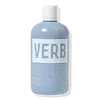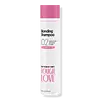What's inside
What's inside
 Key Ingredients
Key Ingredients

No key ingredients
 Benefits
Benefits

 Concerns
Concerns

 Ingredients Side-by-side
Ingredients Side-by-side

Water
Skin ConditioningGlycerin
HumectantCocamidopropyl Betaine
CleansingDisodium Laureth Sulfosuccinate
CleansingSodium Lauroyl Sarcosinate
CleansingSodium C14-16 Olefin Sulfonate
CleansingLaureth-3
EmulsifyingPEG-120 Methyl Glucose Trioleate
CleansingPanthenol
Skin ConditioningCocamide Mea
EmulsifyingGlycol Distearate
EmollientChondrus Crispus Extract
Skin ConditioningAscophyllum Nodosum Extract
Skin ConditioningLaminaria Saccharina Extract
Skin ProtectingPalmaria Palmata Extract
Skin ProtectingUndaria Pinnatifida Extract
Skin ConditioningTrichilia Emetica Seed Butter
EmollientAspergillus Ferment
Skin ConditioningArginine
MaskingXylitylglucoside
HumectantAnhydroxylitol
HumectantXylitol
HumectantSodium Methyl 2-Sulfolaurate
CleansingSodium Lauryl Sulfoacetate
CleansingPropanediol
SolventParfum
MaskingPolyquaternium-7
Dimethicone Pg-Diethylmonium Chloride
Polyquaternium-10
Gluconolactone
Skin ConditioningButylene Glycol
HumectantSodium Chloride
MaskingSilicone Quaternium-20
Skin ConditioningSodium Sulfate
Lauric Acid
CleansingXanthan Gum
EmulsifyingAmodimethicone
Hydroxypropyl Guar Hydroxypropyltrimonium Chloride
Bis-PCA Dimethicone
Cetrimonium Chloride
AntimicrobialQuaternium-80
Sarcosine
Skin ConditioningTrideceth-12
EmulsifyingLinoleamidopropyl Pg-Dimonium Chloride Phosphate Dimethicone
Disodium 2-Sulfolaurate
CleansingHydroxypropylammonium Gluconate
HumectantHydroxypropylgluconamide
HumectantHexylene Glycol
EmulsifyingDisodium PEG-12 Dimethicone Sulfosuccinate
CleansingPropylene Glycol
HumectantIsopropyl Alcohol
SolventMaleic Acid
BufferingCitric Acid
BufferingAminomethyl Propanol
BufferingSodium Acetate
BufferingPotassium Sorbate
PreservativeSodium Benzoate
MaskingCalcium Gluconate
HumectantBenzyl Alcohol
PerfumingTartaric Acid
BufferingDehydroacetic Acid
PreservativeLimonene
PerfumingHexyl Cinnamal
PerfumingHydroxycitronellal
PerfumingLinalool
PerfumingWater, Glycerin, Cocamidopropyl Betaine, Disodium Laureth Sulfosuccinate, Sodium Lauroyl Sarcosinate, Sodium C14-16 Olefin Sulfonate, Laureth-3, PEG-120 Methyl Glucose Trioleate, Panthenol, Cocamide Mea, Glycol Distearate, Chondrus Crispus Extract, Ascophyllum Nodosum Extract, Laminaria Saccharina Extract, Palmaria Palmata Extract, Undaria Pinnatifida Extract, Trichilia Emetica Seed Butter, Aspergillus Ferment, Arginine, Xylitylglucoside, Anhydroxylitol, Xylitol, Sodium Methyl 2-Sulfolaurate, Sodium Lauryl Sulfoacetate, Propanediol, Parfum, Polyquaternium-7, Dimethicone Pg-Diethylmonium Chloride, Polyquaternium-10, Gluconolactone, Butylene Glycol, Sodium Chloride, Silicone Quaternium-20, Sodium Sulfate, Lauric Acid, Xanthan Gum, Amodimethicone, Hydroxypropyl Guar Hydroxypropyltrimonium Chloride, Bis-PCA Dimethicone, Cetrimonium Chloride, Quaternium-80, Sarcosine, Trideceth-12, Linoleamidopropyl Pg-Dimonium Chloride Phosphate Dimethicone, Disodium 2-Sulfolaurate, Hydroxypropylammonium Gluconate, Hydroxypropylgluconamide, Hexylene Glycol, Disodium PEG-12 Dimethicone Sulfosuccinate, Propylene Glycol, Isopropyl Alcohol, Maleic Acid, Citric Acid, Aminomethyl Propanol, Sodium Acetate, Potassium Sorbate, Sodium Benzoate, Calcium Gluconate, Benzyl Alcohol, Tartaric Acid, Dehydroacetic Acid, Limonene, Hexyl Cinnamal, Hydroxycitronellal, Linalool
Water
Skin ConditioningSodium Cocoyl Isethionate
CleansingSodium Lauroyl Sarcosinate
CleansingCocamidopropyl Hydroxysultaine
CleansingGlycol Distearate
EmollientPEG-150 Distearate
EmulsifyingPropanediol
SolventItaconic Acid
AntimicrobialArginine
MaskingPanthenol
Skin ConditioningLinum Usitatissimum Seed Extract
PerfumingSalvia Hispanica Seed Extract
EmollientPolyglyceryl-10 Laurate
Skin ConditioningBis-PCA Dimethicone
Disodium PEG-12 Dimethicone Sulfosuccinate
CleansingPolyquaternium-10
Hydroxypropyl Guar Hydroxypropyltrimonium Chloride
Butylene Glycol
HumectantParfum
MaskingHexyl Cinnamal
PerfumingAlpha-Isomethyl Ionone
PerfumingTetrasodium Glutamate Diacetate
Aminomethyl Propanol
BufferingPhenoxyethanol
PreservativeEthylhexylglycerin
Skin ConditioningCitric Acid
BufferingWater, Sodium Cocoyl Isethionate, Sodium Lauroyl Sarcosinate, Cocamidopropyl Hydroxysultaine, Glycol Distearate, PEG-150 Distearate, Propanediol, Itaconic Acid, Arginine, Panthenol, Linum Usitatissimum Seed Extract, Salvia Hispanica Seed Extract, Polyglyceryl-10 Laurate, Bis-PCA Dimethicone, Disodium PEG-12 Dimethicone Sulfosuccinate, Polyquaternium-10, Hydroxypropyl Guar Hydroxypropyltrimonium Chloride, Butylene Glycol, Parfum, Hexyl Cinnamal, Alpha-Isomethyl Ionone, Tetrasodium Glutamate Diacetate, Aminomethyl Propanol, Phenoxyethanol, Ethylhexylglycerin, Citric Acid
Ingredients Explained
These ingredients are found in both products.
Ingredients higher up in an ingredient list are typically present in a larger amount.
Aminomethyl Propanol is used to adjust the pH of products. It is also used as a base to create other organic compounds. Having a balanced pH is important for protecting your skin.
Aminomethyl propanol is safe to use in cosmetics up to 1%. It is soluble in water.
Arginine is an amino acid that is important for human development. Your body uses is it to produce hair keratin and skin collagen.
As a cosmetic ingredient, Arginine has antioxidant properties and can also help repair damaged skin. This ingredient is derived either synthetically or from animals.
Arginine isn't fungal acne safe when used in the presence of other lipids (fats, fatty acids, oils, esters, etc). Oils and fats occur naturally within the skin, so take caution when using Arginine if you're prone to fungal acne.
Learn more about ArginineBis-PCA Dimethicone is a type of silicone.
Butylene Glycol (or BG) is used within cosmetic products for a few different reasons:
Overall, Butylene Glycol is a safe and well-rounded ingredient that works well with other ingredients.
Though this ingredient works well with most skin types, some people with sensitive skin may experience a reaction such as allergic rashes, closed comedones, or itchiness.
Learn more about Butylene GlycolCitric Acid is an alpha hydroxy acid (AHA) naturally found in citrus fruits like oranges, lemons, and limes.
Like other AHAs, citric acid can exfoliate skin by breaking down the bonds that hold dead skin cells together. This helps reveal smoother and brighter skin underneath.
However, this exfoliating effect only happens at high concentrations (20%) which can be hard to find in cosmetic products.
Due to this, citric acid is usually included in small amounts as a pH adjuster. This helps keep products slightly more acidic and compatible with skin's natural pH.
In skincare formulas, citric acid can:
While it can provide some skin benefits, research shows lactic acid and glycolic acid are generally more effective and less irritating exfoliants.
Most citric acid used in skincare today is made by fermenting sugars (usually from molasses). This synthetic version is identical to the natural citrus form but easier to stabilize and use in formulations.
Read more about some other popular AHA's here:
Learn more about Citric AcidDisodium PEG-12 Dimethicone Sulfosuccinate is a type of silicone.
Glycol Distearate serves as a pearlizing or opacifying agent in cosmetic products.
It's often included in cleansers and haircare products to give them a lustrous or shimmering appearance.
It is derived from stearic acid, a natural fatty acid commonly found in vegetable oils and animal fats.
Glycol Distearate isn't fungal acne safe.
Learn more about Glycol DistearateHexyl Cinnamal is a fragrance ingredient with a similar scent to jasmine. It can be naturally found in chamomile essential oil.
This ingredient is a known EU allergen and may sensitize the skin. The EU requires this ingredient to be listed separately on an ingredients list.
Hexyl Cinnamal is not water soluble but is soluble in oils.
Learn more about Hexyl CinnamalWe don't have a description for Hydroxypropyl Guar Hydroxypropyltrimonium Chloride yet.
Panthenol is a common ingredient that helps hydrate and soothe the skin. It is found naturally in our skin and hair.
There are two forms of panthenol: D and L.
D-panthenol is also known as dexpanthenol. Most cosmetics use dexpanthenol or a mixture of D and L-panthenol.
Panthenol is famous due to its ability to go deeper into the skin's layers. Using this ingredient has numerous pros (and no cons):
Like hyaluronic acid, panthenol is a humectant. Humectants are able to bind and hold large amounts of water to keep skin hydrated.
This ingredient works well for wound healing. It works by increasing tissue in the wound and helps close open wounds.
Once oxidized, panthenol converts to pantothenic acid. Panthothenic acid is found in all living cells.
This ingredient is also referred to as pro-vitamin B5.
Learn more about PanthenolParfum is a catch-all term for an ingredient or more that is used to give a scent to products.
Also called "fragrance", this ingredient can be a blend of hundreds of chemicals or plant oils. This means every product with "fragrance" or "parfum" in the ingredients list is a different mixture.
For instance, Habanolide is a proprietary trade name for a specific aroma chemical. When used as a fragrance ingredient in cosmetics, most aroma chemicals fall under the broad labeling category of “FRAGRANCE” or “PARFUM” according to EU and US regulations.
The term 'parfum' or 'fragrance' is not regulated in many countries. In many cases, it is up to the brand to define this term.
For instance, many brands choose to label themselves as "fragrance-free" because they are not using synthetic fragrances. However, their products may still contain ingredients such as essential oils that are considered a fragrance by INCI standards.
One example is Calendula flower extract. Calendula is an essential oil that still imparts a scent or 'fragrance'.
Depending on the blend, the ingredients in the mixture can cause allergies and sensitivities on the skin. Some ingredients that are known EU allergens include linalool and citronellol.
Parfum can also be used to mask or cover an unpleasant scent.
The bottom line is: not all fragrances/parfum/ingredients are created equally. If you are worried about fragrances, we recommend taking a closer look at an ingredient. And of course, we always recommend speaking with a professional.
Learn more about ParfumPolyquaternium-10 is an ammonium salt of hydroxyethylcellulose. It is a white and granular powder used as a film-former and anti-static agent.
This ingredient is commonly found in hair conditioning products. According to a manufacturer, its positive charge makes it great for absorbing hair proteins. The manufacturer also states this ingredient helps with curl retention.
For haircare friends: this ingredient is not a silicone.
Learn more about Polyquaternium-10Propanediol is an all-star ingredient. It softens, hydrates, and smooths the skin.
It’s often used to:
Propanediol is not likely to cause sensitivity and considered safe to use. It is derived from corn or petroleum with a clear color and no scent.
Learn more about PropanediolSodium Lauroyl Sarcosinate is a cleansing agent and emulsifier. It is a surfactant derived from sarcosine, and a common source is coconut oil.
As a surfactant, Sodium Lauroyl Sarcosinate helps lift dirts, oil, and other molecules to be washed away. In leave-on products, this ingredient is used as an emulsifier. Emulsifier help prevent ingredients such as oils and waters from separating.
Sodium Lauroyl Sarcosinate is also commonly found as a foaming agent in shampoo, toothpaste, and shaving foam. It is amphiphilic, meaning it loves both water and fats.
Learn more about Sodium Lauroyl SarcosinateWater. It's the most common cosmetic ingredient of all. You'll usually see it at the top of ingredient lists, meaning that it makes up the largest part of the product.
So why is it so popular? Water most often acts as a solvent - this means that it helps dissolve other ingredients into the formulation.
You'll also recognize water as that liquid we all need to stay alive. If you see this, drink a glass of water. Stay hydrated!
Learn more about Water